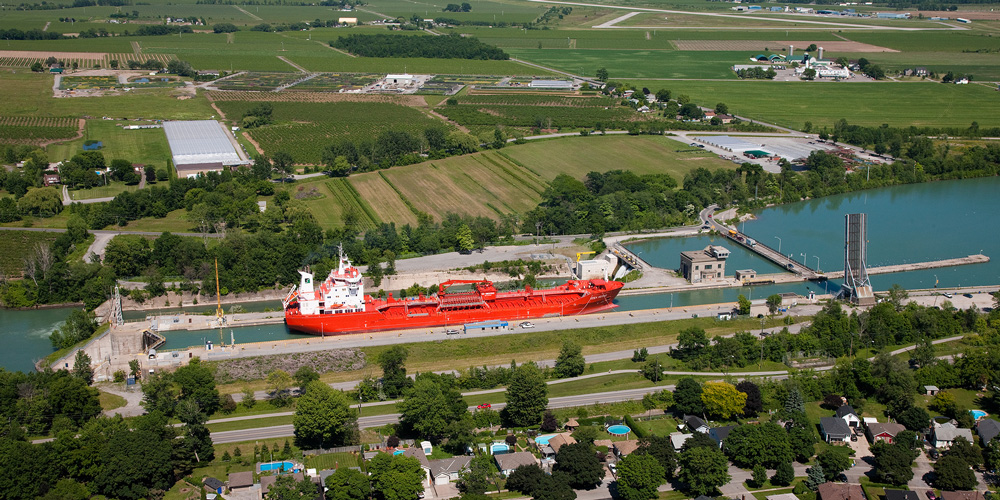Ballast Water Management Standards Enhanced Once Again
January 16, 2008
Press release issued by the U.S. Saint Lawrence Seaway Development Corporation:
U.S. Seaway Proposes Tougher Ballast Water Rules for Ocean Vessels
Regulations proposed by the U.S. Saint Lawrence Seaway Development Corporation (SLSDC) would require all ocean-going ships entering the U.S. sector of the St. Lawrence Seaway beginning with the start of the 2008 navigation season to take new measures to prevent the introduction of invasive species, said SLSDC Administrator Collister Johnson, Jr.
“These new, tougher ballast water regulations will protect the Great Lakes St. Lawrence Seaway ecosystem and permit vital marine commerce to flourish,” Administrator Johnson said.
The new proposal would require vessels to flush ballast tanks containing only small amounts of water or sediment with saltwater in an area 200 nautical miles from any North American shore before entering the Seaway. The proposal also would increase the number of ship inspections for ocean-going vessels performed in Montreal by inspectors from the U.S.-Canadian Seaway Corporations, the U.S. Coast Guard and Transport Canada. Additional inspections would be required for these ‘salties’ making secondary transits and the percentage of tanks subject to inspection would increase. And it requires all ships entering the Seaway to measure the salinity levels of their tanks to assure that there is a sufficiently high concentration of salt in the ballast water to kill invasive species.
Administrator Johnson noted that since 2006 Canada has required that similar vessels transiting the Seaway bound for Canadian ports conduct saltwater flushing. The proposed U.S. rules will ensure that vessels destined for American ports do the same.
A recently published study led by the National Oceanic and Atmospheric Administration and the University of Michigan documented that flushing saltwater into ballast tanks that contain residual amounts of water or sediment is “highly effective” in eradicating most exotic aquatic species potentially introduced into the Great Lakes via ballast water.
Under the proposed rules, ships that fail to saltwater flush may either return to the open ocean to conduct a ballast water exchange or must retain the ballast in their on-board tanks. Non-compliant ships could be fined up to $36,625 per incident by the SLSDC, Johnson added.
Since 1997, the SLSDC, the Canadian St. Lawrence Seaway Management Corporation (SLSMC), Transport Canada and U.S. Coast Guard (USCG) have conducted ballast water inspections in Montreal for vessels conducting their first transit of the shipping season.
Administrator Johnson noted that the proposed rules were developed in collaboration with the SLSMC, Transport Canada, and USCG, which is the lead U.S. organization charged with regulating the ballast water discharge in the U.S. He added that the proposed rule will be operational until the USCG finalizes a comprehensive regulatory program regarding ballast water. “We support these interim regulations proposed by the SLSDC pending the promulgation of national ballast water regulations and procedures by the U.S. Coast Guard,” said Rear Admiral John E. Crowley, Jr., U.S. Ninth Coast Guard District Commander.
The public will have until January 30th to comment on the notice of proposed rulemaking. A final rule will be published in late March, prior to the start of the 2008 navigation season. The notice of proposed rulemaking can be found online at www.regulations.gov.
Press release issued by the Canadian St. Lawrence Seaway Management Corporation:
Cornwall, Ontario (January 16, 2008) – The St. Lawrence Seaway Management Corporation (SLSMC) announced today a further strengthening of ballast water management practices for the 2008 season. The regulatory initiative regarding ballast water management rules by its U.S. partner, the Saint Lawrence Seaway Development Corporation, will result in all ocean vessels being subjected to a consistent and rigorous inspection process in Montreal, before they enter the Seaway / Great Lakes.
Since 2006, all ocean vessels bound for a Canadian port have been subjected to ballast water inspections, to ensure that water within the ballast tanks adheres to a minimum level of salinity of 30 parts per thousand. With the harmonization of U.S. and Canadian standards, all vessels entering the Seaway, irrespective of their destination, will be subjected to the same inspection process.
Beginning with the 2008 navigation season, all ocean vessels, including those with ‘no ballast on board’, will be subjected to an inspection, covering 100% of ballast water tanks. This inspection process will ensure that the vessel – while still a minimum of 200 nautical miles offshore – flushed all of its tanks with salt water. On subsequent transits during the year, the vessel will again be subjected to a series of inspections, with the objective of ensuring that the vessel’s crew is strictly adhering to the salt water flushing practice.
Salt water acts as a natural biocide against fresh water organisms found in ballast water. A recent study led by the U.S. National Oceanic and Atmospheric Administration and the University of Michigan found this practice to be a highly effective means to eradicate organisms suspended in ballast water (including zebra mussels). The new harmonized regulations will ensure that all ocean vessels flush their ballast tanks with salt water, well before they enter U.S. or Canadian waters.
Richard Corfe, President and CEO of the SLSMC, stated that “this agreement demonstrates the resolve of the Seaway corporations, the Canadian and U.S. governments, and that of the marine industry to effectively manage ballast water, and apply industry leading best practices to each and every ocean vessel entering our system.






